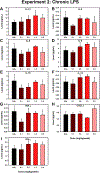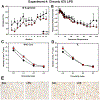Chronic lipopolysaccharide impairs motivation when delivered to the ventricles, but not when delivered peripherally in male rats
- PMID: 36257462
- PMCID: PMC11305111
- DOI: 10.1016/j.physbeh.2022.113998
Chronic lipopolysaccharide impairs motivation when delivered to the ventricles, but not when delivered peripherally in male rats
Abstract
Increased neuroinflammation relative to controls is observed in major depression. Moreover, depressive disorders are significantly elevated in conditions which increase neuroinflammation (e.g., brain injury, Parkinson's disease, Alzheimer's disease). To better understand the relationship between neuroinflammation and depression, additional research is needed. The current set of studies made use of the progressive ratio (PR) task in male rats, a stable measure of motivation which can be evaluated daily and thus is ideally suited for examining a potential role for chronic neuroinflammation in depressive-like behavior. Lipopolysaccharide (LPS) was used to induce an inflammatory response. Experiment 1 confirmed prior acute LPS administration experiments for sensitivity of the PR task, with a large effect at 2 mg/kg, a partial effect at 1 mg/kg, and no effect at 0.5 mg/kg. Experiment 2 evaluated a dose-response of continuous s.c. LPS infusion but found no significant elevation in brain cytokines after 14 days at any doses of 0.1, 0.5, 1, or 2 mg/kg/week. Experiment 3 assessed motivation during continuous s.c. infusion of a large 5 mg/kg/week LPS dose and found no significant impairments in motivation, but transient decreases in rates of lever pressing (i.e., only motoric deficits). Experiment 4 measured motivation during continuous ICV infusion of 10.5 μg/kg/week LPS and found significantly decreased motivation without changes to rates of lever pressing (i.e., only motivational deficits). Together these results suggest that the PR task is efficient for evaluating models of chronic inflammation, and that the adaptive response to chronic LPS exposure, even when delivered centrally, may necessitate alternative strategies for generating long-term neuroinflammation.
Keywords: Depression; LPS; Progressive ratio; Rat.
Copyright © 2022. Published by Elsevier Inc.
Conflict of interest statement
Declaration of Competing Interest The authors have no financial or competing interests in the outcome of this research.
Figures





Similar articles
-
Effect of acute lipopolysaccharide-induced inflammation in intracerebroventricular-streptozotocin injected rats.Neuropharmacology. 2016 Feb;101:110-22. doi: 10.1016/j.neuropharm.2015.08.044. Epub 2015 Aug 29. Neuropharmacology. 2016. PMID: 26327677
-
The Effects of Probiotic Formulation Pretreatment (Lactobacillus helveticus R0052 and Bifidobacterium longum R0175) on a Lipopolysaccharide Rat Model.J Am Coll Nutr. 2019 Mar-Apr;38(3):209-217. doi: 10.1080/07315724.2018.1487346. Epub 2018 Oct 11. J Am Coll Nutr. 2019. PMID: 30307792
-
Exendin-4 Treatment Improves LPS-Induced Depressive-Like Behavior Without Affecting Pro-Inflammatory Cytokines.J Parkinsons Dis. 2017;7(2):263-273. doi: 10.3233/JPD-171068. J Parkinsons Dis. 2017. PMID: 28387682 Free PMC article.
-
Intermittent fasting attenuates lipopolysaccharide-induced neuroinflammation and memory impairment.J Neuroinflammation. 2014 May 6;11:85. doi: 10.1186/1742-2094-11-85. J Neuroinflammation. 2014. PMID: 24886300 Free PMC article.
-
Behavioral and systemic consequences of long-term inflammatory challenge.J Neuroimmunol. 2015 Nov 15;288:40-6. doi: 10.1016/j.jneuroim.2015.08.011. Epub 2015 Aug 28. J Neuroimmunol. 2015. PMID: 26531693
References
-
- Köhler CA, et al., Peripheral cytokine and chemokine alterations in depression: A meta-analysis of 82 studies. Acta Psychiatrica Scandinavica, 2017. 135(5): p. 373–387. - PubMed
-
- Munkholm K, et al., Cytokines in bipolar disorder vs. healthy control subjects: A systematic review and meta-analysis. Journal of Psychiatric Research, 2013. 47(9): p. 1119–33. - PubMed
-
- Enache D, Pariante CM, and Mondelli V, Markers of central inflammation in major depressive disorder: A systematic review and meta-analysis of studies examining cerebrospinal fluid, positron emission tomography and post-mortem brain tissue. Brain Behavior and Immunity, 2019. 81: p. 24–40. - PubMed
Publication types
MeSH terms
Substances
Grants and funding
LinkOut - more resources
Full Text Sources
Research Materials

